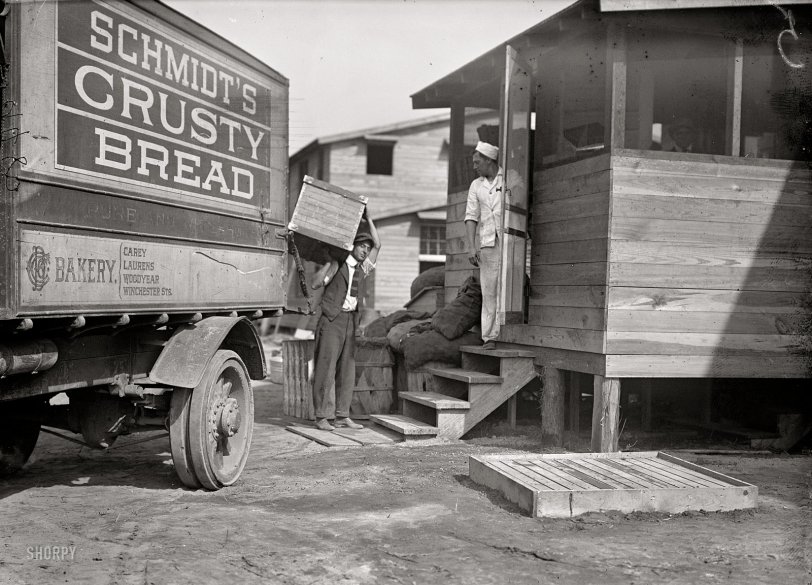


Framed or unframed, desk size to sofa size, printed by us in Arizona and Alabama since 2007. Explore now.
Shorpy is funded by you. Patreon contributors get an ad-free experience.
Learn more.

- S&P
- 1940 Zenith radio model 6G601
- Quality goes in before the name goes on!
- Snazzy skirt
- Carbon Arc Lamps
- Illuminate us
- I remember it well
- I can't prove it
- Complicated then, forgotten now
- Bryan-Stevenson
- Skinny is as skinny does
- How do you rest in peace
- Riding the footboards
- Alas, hidden from view
- Baldwin Diesels
- Exclusive pump
- Bananas, Oysters and Smokey Joe
- Details, Details
- What's that building to the left of the tower?
- Coal Barges
- Bromo-Seltzer
- Inner harbor
- The Basin
- What a headache!
- Giant stepladder?
- Yeah, it was cold
- Love those coats
- Link & Pin Days Remnant
- Baldwin 62303
- Baldwin VO-1000
Print Emporium
Crusty Schmidt: 1917
Lift That Bale
Here we have another guy in a necktie doing some heavy lifting. That crate looks like it's made of wood. His life could have been easier with some sort of cardboard or masonite container.
Bread for the troops
Bread for soldiers from civilian sources is, or was not unusual. My father was an employee of Colonial Bakery in Fort Smith, Arkansas during WWII. The bakery provided bread for nearby Camp (later Fort, now closed) Chaffee. The draft board (or other authority) declared his job as essential to the war effort. As a result, he could not quit his job, the bakery could not fire him, he could not be drafted, nor could he volunteer for the Armed Forces. He was to bake bread for the duration of the war. Since gas was rationed tightly, he sold our car and rode a bicycle to work until the end of the war. He stayed with the bakery for a 49-year career.
Schmidt's
The Schmidt Bakery is still around, though they no longer hawk "crusty bread". Started in 1886 by German immigrants, it is still family owned (run by their great-grandson) and has bakeries in Baltimore and Fullerton.
Schmidt's potato bread is, by the way, outstanding. Yum.
Civilian bread
Civilian Bread being delivered to the cook? When I was in during the Korean mess, all of our bread was made at the Fort Jackson Army bakery and always seemed to be day old. Got pretty used to it until one happy day the camp bakery broke down and they supplied us with "civilian" bread. Man, that was real eating and I have never forgotten that day. Yummmm!
Also, look at all those sacks of taters that some poor KPs are going to have to peel though I was never assigned to that detail. Fort Jackson (SC) used coal fired ranges while I was there that had to be cleaned once a week by rubbing them internally with brickbats so they would pass Saturday inspection.
Speed , not comfort
I can't imagine the spine shattering ride on those tires.
Camp to Fort
I spent the last 6 months of my Army service during the Vietnam War at what was had been upgraded to "Fort" Meade, and was discharged in July 1967. At the time I was living with my wife in Arlington, Va., and commuted daily 40 miles each direction in my Renault Dauphine to make early formation.
Truck's wheels
I'm fascinated by the fact that the truck appears to have no tires. I haven't seen many (if any) trucks from this period. It must have been a nightmare to drive.
[The truck has solid rubber tires. - Dave]
Look at those tires!
Dear Lord, look at the tire on the truck. It appears to be solid rubber.
This means a bone-shaking jolt for the driver every time he runs over so much as a nickel.
Worse: the wheels will frequently be out of contact with the pavement, making skids far more likely than with pneumatic tires.
Having to lug 100-pound crates around may be the least of our nattily-dressed driver's issues.
Mmm Crusty bread
I'm guessing that "Crusty" is a good thing, back then anyway. BTW, put some air in those tires, will ya!

























On Shorpy:
Today’s Top 5